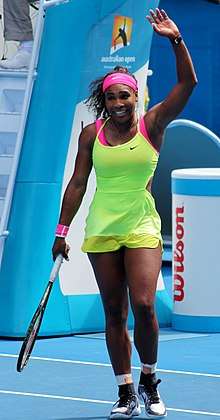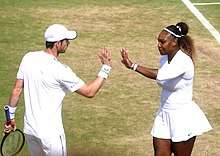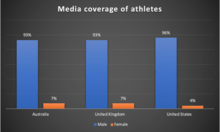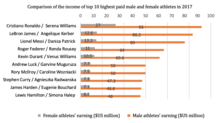Gender pay gap in sports
Gender pay gap in sports looks into the persistence of unequal pay in sports, particularly for female athletes who do not receive equal revenue compared to their counterparts. According to the research conducted by BBC, "a total of 83% of sports now reward men and women equally".[1] However, it does not mean that the wage gap in sports has narrowed or disappeared. In 2018, Forbes released the list of the top 100 highest-paid athletes, and they are all male athletes.[2] A similar situation also occurred in 2017, where there was only one female athlete — tennis player Serena Williams — who joined the list and ranked No.56.


Factors
Except for prize money, there are other factors that affect female athletes' income, which include both internal and external factors.
Endorsement deals
The first factor is the fewer chances for female athletes to negotiate with endorsement deals. Assuming a male and female athlete receives equal prize money, generally speaking, the top male athletes earn more due to better sponsorship and endorsement deals.[3] Research conducted by a United Kingdom's organisation shows that sponsors are more attracted by male athletes as male athletes tend to be more marketable.[4] A study has found that female athletes are rarely employed as the spokesperson by companies.[5] The imbalance of endorsement deals expands the income gap between male and female athletes. Comparison of Roger Federer’s income with Serena Williams' income based on their prize money shows that Williams earned 2 million dollars more than Federer. However, Federer is the most lucrative athlete endorsement and makes $58 million, which is three times than Serena Williams.[6]
Media coverage

Media coverage takes forms such as news reports, television programs, and social media articles. Media coverage does not only enhance the popularity of athletes but also reveals the commercial nature of sports.[7] Male’s sports have higher production values and are going to seem more exciting.[8] Novak Djokovic, the former world No.1 in men's single tennis said that male players deserve to be paid more than female players because "statistics are showing that we have much more spectators on the men’s tennis matches", which means male athletes have gained more interests and attention.[9] The economic logic is, the viewership determines the commercial value of a sport, as the media producers hope to attract more audiences to make profits. This factor may affect the media coverage of female athletes. In Australia, female's sports make up 7% of all sports media coverage, the same as the United Kingdom. Similarly, in the United States, nearly 40% of athletes are female, but they own 2%-4% media coverages.[10] Except for the quantity, the quality of media coverage also matters. The media portrayal of female athletes tends to be less professional, and sometimes involve entertaining or sexualised contents instead of portraying their athletic abilities.[11]
Economic return
Economic elements also affect the pay equity sports. In 2018, the WNBA team attracted 7,716 fans per game, which is more than 10,000 fans below the audience attracted by NBA teams per game.[12] Female teams attracted fewer fans compares to male teams, indicates female teams sold less ticket and hence generated less revenue. The highest-paid female wrestler Ronda Rousey says she thinks how many female athletes get paid should relate to how much revenue they bring in.[13] The different marketability of athletes affects the corresponding earnings of male and female athletes. The economic benefits will occur as long as female athletes generate outstanding revenue as their male counterparts do.[14]
Biological difference
Female athletes do not have the same level of athletic performance as male athletes. The study has shown that compares to females, males have more muscle, higher blood volume, and more red blood cells, and those differences can be 30% in individuals.[15] Currently, male athletes have better world records than female athletes. Take the case of running, swimming and skating; each sport reveals the fact that male athletes' world record was about 10% more than female athletes' record.[16] It is difficult for female athletes to compete against male athletes. In 1998, Karsten Braasch — the male tennis player who ranked at No.203 in the world beat Serena Williams 6-1 and Venus Williams 6-2 after the Williams sisters claimed that they are capable of beating any male player ranked outside the world's top 200.
Others
There are other factors which also affect the earning of female athletes — for example, the lack of women holding governing positions in the sports organisation. In Europe sports foundations, there are 14% of all decision-making positions which are occupied by women.[17] Motherhood also reduces the earning of female athletes as they miss many chances of attending tournaments due to their physical condition. After the labour, it still takes time to train and rebuild the body shape.[18] Pregnancy brings a commercial difference, and this mainly reflects through endorsement deals.[19] Professional beach volleyball player Kerri Walsh once said that she was told to hold off on starting a new family by sponsors. The professional snowboarder Kimmy Fasani also faced the fear of losing her endorsement deals when she found out she is pregnant.[20]
The WNBA and NBA is one of the most prominent examples of the pay gap. In 2018, Aja Wilson was drafted the number one pick and earned a salary of $52,564. DeAndre Ayton, was drafted the number one pick in the NBA and earned a salary of $5,091,500.
The average max salary cap for a player in the WNBA is roughly about $117,500. For an NBA player its about 300 times more than that. For example, Lebron James sits at $33.3 million and Steph Curry sits at $34.7 million.
WNBA's low ticket sales and low salary may be due to marketing, as more resources are devoted to the NBA than the WNBA. Top NBA players are encouraged to appeal to female viewers.[21]
In 2019, the WNBA signed a deal with CBS to broadcast 40 games a year. ESPN will also broadcast an additional 16 games on their network. NBATV will also broadcast more games as well.
Impacts
Gender pay gap in sports links to the broader world and causes wider imbalance. In the financial point of view, this issue may cause the loss of financial revenue, as the pay gap in sports may lead to the less incentive of the female athletes to push themselves and to actively participate in sports because they feel unsupported.[22] Except for professional athletes, other female participation in sports may also be affected. Ruth Holdaway, the chief executive officer at advocacy group Women in Sport, says if the public aims to close the pay gap in the long term, the public should be working with young girls to let them understand that sports are worth participating. Closing the pay gap in sports helps to create an environment where all female participation can enjoy equal rights as males.[23]
Public response
Female athletes' actions
Some professional female athletes take steps forward to oppose the pay gap. One of the most noteworthy cases happens in tennis. In 2006, American tennis player Venus Williams wrote an open letter to the London Times after won the championship of Wimbledon but received lower prize money compared with her male counterpart.[24] In that letter, Williams questioned that the disparity in prize money disregards female's hard work and Wimbledon conveys a faulty value. Williams' letter had drawn the attention of the public. Tony Blair, the Prime Minister of the United Kingdom at that time, started to focus on the issue of the pay disparity in sports.[25] In the followed year, Wimbledon adjusted the prize money structure and offered an equal amount of prize money to male and female athletes.
Introducing regulations
Introducing official regulations also plays an essential role in closing the pay gap in sports. The Male Champions of Change (MCC) is an Australian institute which redefines men's role in "taking action on gender inequality and encourage men of power and influence to contribute to gender equality issues in the communities".[26] In 2019, MCC released the report of Pathway to Pay Equality, which aims to create new systems and cultures which can breed pay equity across all elite sports.[27] The report details the specific actions and supports need to be taken to close the gender pay gap in sports. Pathway to Pay Equality assembles 17 Australian sporting chief executives as the signatories, to ensure female athletes have the same rights and opportunities in sports by evaluating and reporting their performance annually. The report introduced by MCC is considered to be the first time that the sports organisations have united globally to address the issue of unequal pay in sports, this can be a role model for other countries and institutes to emulate.[28]
Statistics
Some popular and widespread sports still retain a significant pay gap. The following statistics show the income disparities between female athletes and their male counterparts.

In football, the United States women's national football team is paid almost four times less than the men's team.[29] The women's team won the 2014 World Cup tournament but was paid $7 million prize money less than their male counterparts who failed in Round 16. In 2016, the two-time Olympic gold medallist, American football player Hope Amelia Solo files lawsuit against the U.S Soccer Federation for disregarding pay equity with her teammates.
The pay gap in basketball also exists. In 2014, 5 teams of the Women's National Basketball Association (WNBA) out of overall 12 made a profit.[30] In 2017, the WNBA's average salary was $71,635, while the minimum salary for the National Basketball Association (NBA) is $838,464.[31] The WNBA player who received the highest income is nearly one-fifth of the income of the lowest-paid NBA player.[32]
The gender pay gap in golf is far from over. According to Golf Support, the prize money disparity between male and female athletes is 83% in professional golf. If a male and female golf player both wins a tournament, the male player can earn 6 times more than the female player.[33] The Professional Golfers Association offers female athletes $50 million of prize money, far less than $256 million which devotes to male athletes.
The income disparity in professional skiing is outstanding, too. The U.S Olympian ski racer Lindsey Vonn points out that to those female ski racers who are not at the top, many of them have to give up their practice time to do part-time jobs to increase their income due to the insufficient prize money they receive.[34] For Vonn, although she has won Olympic medals and World Cup titles, a large part of her income comes from endorsements instead of prize money.
Despite the disparity, statistics also show the equity of income in sports. Global research conducted by BBC Sport found that in the total of 44 sports that have been surveyed, 35 sports reward the same prize money to male and female athletes which shows an improvement compares to previous years.[35] The following examples are sports which offer equal prize money.
Tennis has been considered as the leader of pay equity in sports. In 1973, the American tennis player Billie Jean King moved into areas of pay equity in tennis. Her efforts led to the change of the prize money of the United States Open.[36] Starting with the United States Open, up to now, all of the four Grand Slam tournaments offer the same prize money to female and male athletes.[37] The list of the top 10 highest-paid female athletes in 2018 released by Forbes shows that tennis is the best-paying sports for female athletes as eight tennis player joined that list.[38] In 2019, Serena WIlliams is the highest of all women's tennis players on the Forbes World's Highest-Paid Athletes list. She currently is sitting at number sixty-three. Williams is the highest of all female athletes on the list.[39]
Volleyball is also one of the pioneers of promoting pay equity in sports. The International Volleyball Federation (FIVB) rewards the same prize money to both female and male athletes since 2004.[40] Specifically, in 2015, the winning male team and female team were all rewarded the equal prize money of $60,000.[41]
The World Surf League (WSL) has altered the prize money structure and announced that female and males athletes would be paid the same amount of prize money from 2019 season in all the range of events that WSL controlled. This announcement also says that equal prize money campaign will also be managed to introduce to the second-tier surfing matches.[42]
References
- "Women's Sport Week 2017: Gender prize money gap narrowing, new study shows". 2017-06-19. Retrieved 2019-05-09.
- "The World's Highest Paid Athletes 2018". Forbes. Retrieved 2019-05-09.
- Perasso, Valeria (2017-10-23). "Is the gender pay gap in sport closing?". Retrieved 2019-05-09.
- "Sports sponsors overwhelmingly favour men over women". www.playthegame.org. Retrieved 2019-05-15.
- "Few female athletes get endorsement deals". Futurity. 2012-08-28. Retrieved 2019-05-09.
- "1. Cristiano Ronaldo". Forbes. Retrieved 2019-05-16.
- Perry, Monique; Ramiscal, Kayla (2019-03-08). "Women's sport: If we build it, they will come". Mumbrella. Retrieved 2019-05-15.
- Bodenner, Chris (2015-06-09). "Why Aren't Women's Sports as Big as Men's?". The Atlantic. Retrieved 2019-05-16.
- Association, Press (2016-03-21). "Novak Djokovic: men's tennis should fight for more prize money than women". The Guardian. ISSN 0261-3077. Retrieved 2019-05-15.
- TuckerCenter (2015-07-29), Media Coverage and Female Athletes - Full Documentary, retrieved 2019-05-15
- "How the Media Portrays Female Athletes". How the Media Portrays Female Athletes. Retrieved 2019-05-15.
- Berri, David. "Basketball's Growing Gender Wage Gap: The Evidence The WNBA Is Underpaying Players". Forbes. Retrieved 2019-05-15.
- "Ronda Rousey Explains Why She Deserves To Make More Money Than Male Fighters". UPROXX. 2015-10-19. Retrieved 2019-05-15.
- "'Gender wage gap' in sport makes perfect sense". Herald Sun. 2019-04-16. Retrieved 2019-05-15.
- Netto, Kevin. "Should women athletes earn the same as men? The science says they work as hard". The Conversation. Retrieved 2019-05-15.
- Meyer, Robinson (2012-08-09). "We Thought Female Athletes Were Catching Up to Men, but They're Not". The Atlantic. Retrieved 2019-05-15.
- "Sport". European Institute for Gender Equality. Retrieved 2019-05-09.
- Pearce, Linda (2015-07-06). "Women in sport: when pregnancy spells the end of a career". The Sydney Morning Herald. Retrieved 2019-05-15.
- Draznin, Haley (2018-02-26). "What pregnancy means for top female athletes and endorsements". CNNMoney. Retrieved 2019-05-09.
- "What pregnancy means for top female athletes and endorsements". www.kq2.com. Retrieved 2019-05-09.
- Regehr, Carly (2019-02-27). "NBA's marketing game plan is light years ahead of the WNBA's". Swish Appeal. Retrieved 2019-12-04.
- "Why Should We Care about the Gender Pay Gap in Professional Sports?". www.americanbar.org. Retrieved 2019-05-09.
- Qvist, Bella (2015-07-16). "Fair play: business can help kick sexism out of sport". The Guardian. ISSN 0261-3077. Retrieved 2019-05-09.
- "The inspiring story of how Venus Williams helped win equal pay for women players at Wimbledon". Women in the World. 2015-07-10. Retrieved 2019-05-09.
- "How 4 pro athletes are helping to close the pay gap". Workopolis Blog. 2017-10-25. Retrieved 2019-05-09.
- "About the Male Champions of Change". Male Champions of Change. Retrieved 2019-05-09.
- Pathway to Pay Equality 2019. Male Champions of Change Sport. 2019.
- "Sports teaming up to close the gender pay gap". ABC News. 2019-02-18. Retrieved 2019-05-09.
- McCarthy, Niall. "Soccer's Ridiculous Gender Wage Gap [Infographic]". Forbes. Retrieved 2019-05-09.
- "How to fix the gender wage gap in sports | nyra`s focused inquiry II site". rampages.us. Retrieved 2019-05-09.
- Lough, Nancy. "The case for boosting WNBA player salaries". The Conversation. Retrieved 2019-05-09.
- Brennan, Andrew. "Which Sports Have The Largest And Smallest Pay Gaps?". Forbes. Retrieved 2019-05-09.
- "How Big is Golf's Gender Pay Gap?". Golfsupport Blog. 2016-02-17. Retrieved 2019-05-09.
- Elkins, Kathleen (2018-04-10). "Olympian Lindsey Vonn: The wage gap in professional skiing is 'severe'". www.cnbc.com. Retrieved 2019-05-09.
- "Prize money in sport - BBC Sport study". 2017-06-18. Retrieved 2019-05-17.
- Salam, Maya (2019-03-11). "The Long Fight for Pay Equality in Sports". The New York Times. ISSN 0362-4331. Retrieved 2019-05-30.
- "Follow the money: How the pay gap in Grand Slam tennis finally closed". ESPN.com. 2018-09-07. Retrieved 2019-05-16.
- Badenhausen, Kurt. "The Highest-Paid Female Athletes 2018". Forbes. Retrieved 2019-05-16.
- "The World's Highest-Paid Athletes". Forbes.
- Cross, Kim (2018-09-13). "Equal Prize Money for Women Is Great—But It's Only Half the Story". Outside Online. Retrieved 2019-05-17.
- "Prize Money - FIVB Beach Volleyball World Championships The Netherlands 2015". netherlands2015.fivb.org. Retrieved 2019-05-17.
- "World Surf League to introduce equal prize money for men's and women's tours". ABC News. 2018-09-06. Retrieved 2019-05-16.